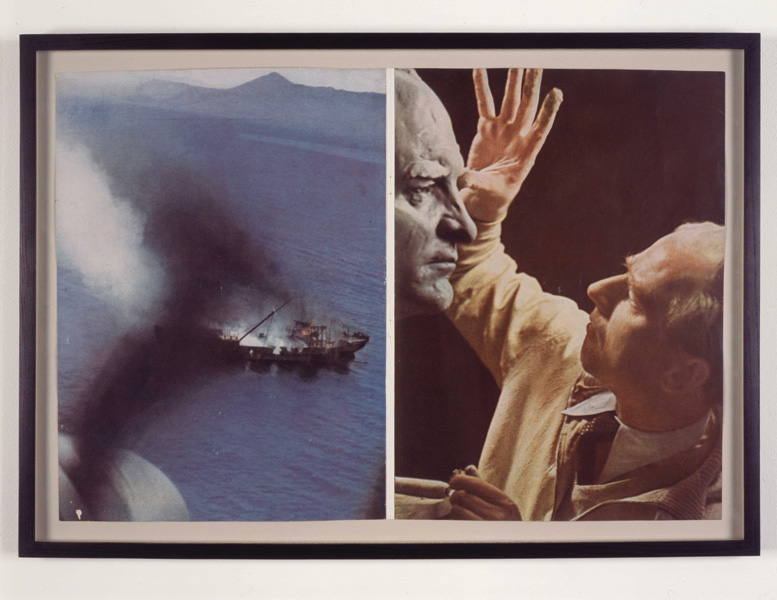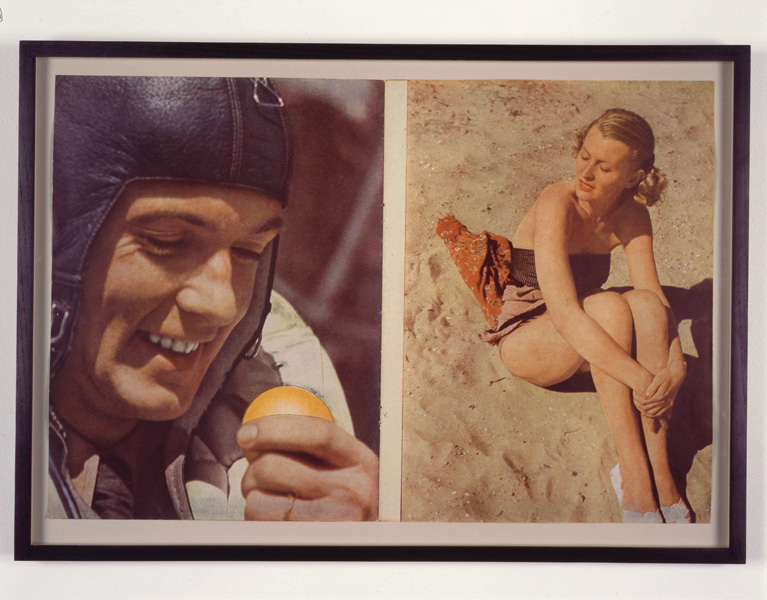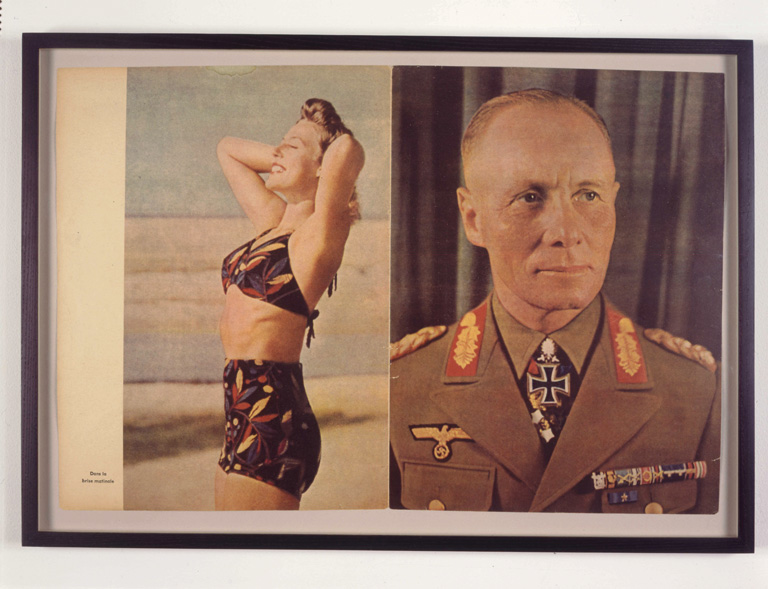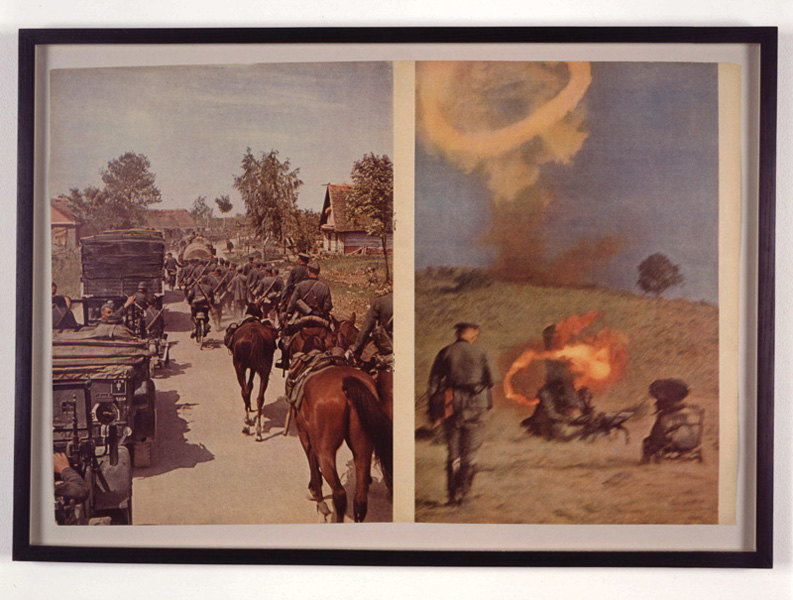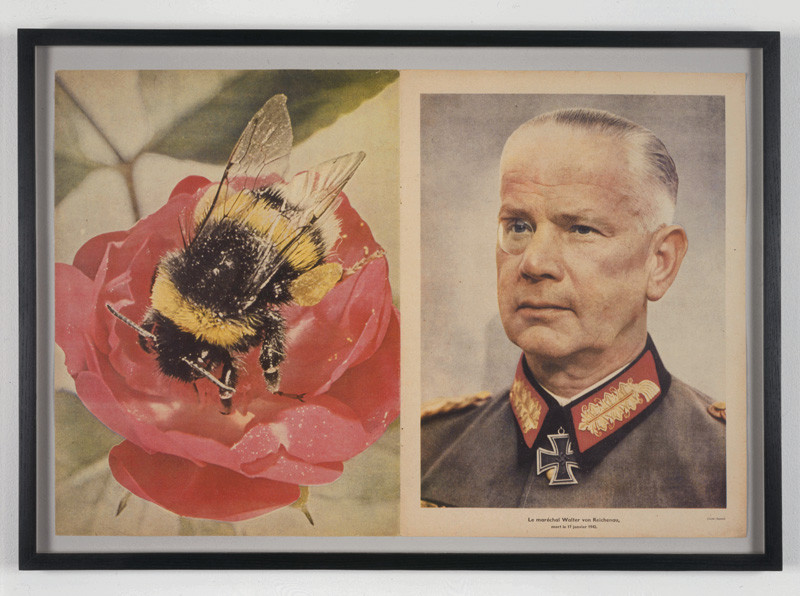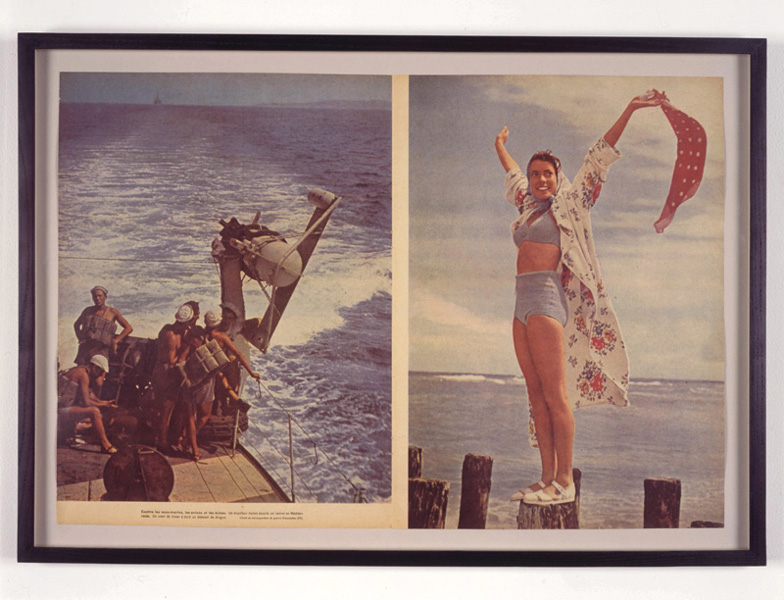[Fall 2009]
by Anne Bénichou
In 2004, the Max-Planck-Institut für Geschichte (Max Planck Institute for History), where research is conducted on the epistemological interplay of historical disciplines, published Signal. Christian Boltanski.1 The book is part of the series Von der künstlerischen Produk- tion der Geschichte (On Art Production through History), in which the historian Bernhard Jussen reflects on contemporary artists whose practices question historical methods and accounts: Jochen Gerz, Anne and Patrick Poirier, Hanne Darboven, Ferne Zwecke, Ulrike Grossarth, and others.
Jussen invited Boltanski to work from the French edition of the German Nazi propaganda magazine Signal, issues of which Boltanski had purchased in a Paris flea market. Produced by the high command of the Wehrmacht (armed forces of the Third Reich) and pub- lished by Deutscher Verlag under the control of the ministry of propaganda, Signal had a print run of 2.5 million copies every two weeks between April 1940 and March 1945. Translated into some twenty-five languages, distributed and sold in almost every country, Allied, neutral, and occupied, in Europe – with the exception of Germany – the magazine was dubbed the “journal of new Europe”; its purpose was to construct a pan-European identity under German domination for the post-war period. Signal was emblematic of the turning point that Nazi propaganda took in the early 1940s. The propagandists who had vaunted the superiority of the Third Reich and the “Aryan race” to an essentially German and Germanophile public wanted to transcend the nation, create a sense of complicity with populations of occupied countries, and drum up the support of various nationalities for a common project. A federative theme appeared: the new Europe united against the Bolshevik terror.2 The magazine’s stunning success, including in occupied countries (800,000 copies were sold in France; England and the United States received the English-language edition), was due to its high editorial quality. The first editor of Signal, Harald Lechenperg, a pioneer of photojournalism, had edited the famous Berliner Illustrierten Zeitschrift. He designed the layout for Signal in the image of its main competitors, the French magazine Match and the American weekly Life, created several years before. Sophisticated printing techniques, glossy paper, full-colour covers and double-page spreads, abundant illustration, photo reports produced by a team of photojournalists, and supplements, many of them in colour, made it a very modern journalistic product, capable of waging a fierce propaganda war with the media of enemy countries.
Boltanski’s intervention on copies of Signal was minimal and consisted of making “random collages.”3 He unstapled the magazines and selected colour double-page spreads, with no or very little text on them, that presented two full-page images evoking contradictory worlds: war, technology, and military industries on the one hand, entertainment, sports, and nature on the other. The diptychs thus created correspond not to the sequence of images in the magazine, but to their arrangement on the printing plates. The violent iconographic contrasts are thus counterbalanced by the chromatic unity of the images. Boltanski draws on the randomness engendered by the printing process, a technique that he knows very well, since he has regularly made use of the print medium and the format of the artist’s book since the late 1960s.
Although the images are decontextualized and their placement side by side is random, the judicious choice of diptychs lays bare the rhetoric and symbolism of Nazi propaganda by making it more legible. The threat of destruction is the promise of plenitude: a Wehrmacht airplane flies over Greece, while three women lounge on a sailboat off the Italian coast. Collective labour allowed new technologies to be developed that were put into service of both destruction and mass entertainment. A photograph of soldiers doing maintenance on a Panzer, the German army tank, is paired with a still of the actor Hans Albers sitting astride a cannonball from the film Münchhausen. Produced in 1943 by the German studio UFA for its twenty-fifth anniversary, Münchhausen was one of the biggest movie productions of Nazi Germany. The film had a colossal budget; the credits included the most famous actors of the Third Reich; there were numerous special effects; and a new colour film technology, Agfacolor, was used. In another diptych, and using the same rhetoric, Stukas war planes strafing Soviet tanks are juxtaposed with an image from the musical The Woman of My Dreams, shot in 1944 and starring the celebrated Marika Rökk, also produced by UFA in Agfacolor. Commissioned and funded by the minister of propaganda, Joseph Goebbels, these light, entertaining super-pro- ductions were intended to demonstrate the superiority of the German film industry to the entire world, espe- cially the United States and Hollywood (where colour films were shot in Technicolor).
Otto Gerhard Oexle maintains that these iconographic associations summarize the Goebbels’s concept of propaganda. Goebbels considered entertainment an essential political instrument,4 a powerful tool for “manipulation of the masses,” and “a decisive force in the war effort.” It was “of military importance,” he wrote in his journal, “to keep our people in good spirit.”5 According to Jussen, the diptychs selected by Boltanski also highlight the dilemma faced by the editors of Signal, who were torn between the priorities of the Wehrmacht – the army and the war – and those of Goebbels and his ministry – images of culture and nature to the detriment of military subjects.6
Boltanski does not consider the plates in Signal to be artworks in themselves. They are, rather, “documents” that he exhibits neither in museums nor in galleries. He sees the book Signal. Christian Boltanski, in which they are reproduced as spreads, as an ideal space for dissemination. At the symposium at the Max Planck Institute for History, in Göttingen, they were framed and hung, but among the library’s book-shelves. In 2008, during the artists’ meetings at the École normale supérieure in Paris, the framed diptychs were placed on the tables in the library, while Boltanski and Jussen debated with the students about the artist’s view of Signal.7 On this occasion, Boltanski stated, “[These plates] do not interest me as objects. [They] are here as evidence of the reality of non-collage,” due to the perforations left by the staples, which demonstrate that he did not create the iconographic juxtapositions. The space of these diptychs is that of print (the book, the library), of historiographic discourse and debate (the essays in the publications, the displays, the students’ questions). Boltanski’s Signal is a question posed to historians and their discursive productions.8
diptychs selected by Boltanski also highlight the dilemma faced by the editors of Signal, who were torn between the priorities of the Wehrmacht – the army and the war – and those of Goebbels and his ministry – images of culture and nature to the detriment of military subjects.
Just once, in 1993, Boltanski presented three diptychs in a museum context, as part of an installation called Derrière les portes closes (Behind Closed Doors), at Museum Abteiberg in Mönchengladbach. In the mechanical rooms adjacent to the exhibition halls, he displayed works from the collection from the Nazi period and added three diptychs from Signal. Viewers could glimpse them through doors left ajar. These artefacts formed a subtext for the permanent exhibitions focused on European avant-gardes, a questioning of the way in which art historians and museum curators represent the modernity of art, and the obliterations that they perform. It is also a question posed of history.
The encounter of “total war” and entertainment, the dramatic and the insignificant, presented in Signal is found in a number of Boltanski’s works, including 6 septembres, a montage of sixty years of newsreels and then television news, considerably accelerated, dating from the day of Boltanski’s birth. In the resulting film, human tragedies and frivolous news items are intermingled. 6 septembres, like Signal, speaks of how media and news images “deliver the world” to us. What understanding can we draw from this lack of differentiation and flattening? These questions were raised in the 1920s by intellectuals who feared that the abundance and repetition of photographs in weeklies would annihilate readers’ mnemonic and cognitive faculties. Siegfried Kracauer, for example, compared this massive dissemination of images to non-selective memory.
What can artists do faced with this phenomenon? While Boltanski presents his approach as an attitude of withdrawal, even renunciation – “a simple question of how we receive the world,” he says – it seems to me that Signal and 6 septembres go beyond simple observation. They accentuate the rhetoric of images, discreetly but sufficiently to draw our regard, as the question what is given to us to look at, in both totalitarian and democratic states. The debate that recently surrounded the exhibition of colour photographs by André Zucca at the Bibliothèque historique de la ville de Paris, Les Parisiens sous l’Occupation,9 demonstrates the need to continue this decoding. The organizers seem to have forgotten that these snapshots of a joyful, sun-filled Paris did not so much testify to daily life in the occupied capital city as participate in construction of the Nazi myth of new Europe by a photographer employed by Signal, generously sup- plied with 16 ASA Agfacolor reversal film … which can be used only in good weather.
Translated by Käthe Roth
2 On this turning point in Nazi propaganda, see Fabrice d’Almeida, Images et propagande (Florence: Caterman-Giunti, 1995), pp. 107–110.
3 Christian Boltanski, Exposition-conférence de Christian Boltanski, organized by Monique Canto-Sperber, Paris, École normale supérieure, 8 April 2008. Online: http://www.diffusion.ens.fr/index.php? res=conf&idconf=1985# (consulted 8 July 2009). All quotations by Boltanski in this article come from this presentation (our translation).
4 Otto Gerhard Oexle, “Christian Boltanski: Memoria and Cultural Memory,” in Bernhard Jussen (ed.), Signal. Christian Boltanski (Göttingen: Max-Planck-Instituts für Geschichte, Wallstein Verlag, 2004), pp. 83–101.
5 Joseph Goebbels, quoted in Oexle, “Christian Boltanski,”p.98.
6 Bernhard Jussen, “Signal – An Introduction,” in Jussen, Signal, p.57.
7 Boltanski, Exposition-conférence.
8 We may now regret the marketing of an edition of one hundred facsimiles, signed by the artist, of one of the diptychs from Signal by Galerie Serge Ziegler, in Switzerland, the neutral country in which Signal had the best distribution.
9 Les Parisiens sous l’Occupation. Photographies en couleurs d’André Zucca, Bibliothèque historique de la ville de Paris, 20 March–1 July 2008.
Anne Bénichou is a historian and theoretician of contemporary art. She has written about archives, memorial forms, and historical accounts issuing from contemporary art practices and from the institutions responsible for preserving and displaying them. She is also interested in the documentation and transmission of ephemeral and evolving works. In 2010, she will publish the edited work Ouvrir le document. Enjeux et pratiques de la documentation dans les arts visuels contemporains (Presses du réel). She teaches at the Université du Québec à Montréal.
Exploring the themes of identity, absence, mourning, and anonymity, Christian Boltanski is best known for his installations using found photographs, objects, and clothing. He has produced a number of artist’s books in which he blurs the boundary between documentary and fiction, playing on the narrative possibilities engendered by his montages and juxtapositions of images. Boltanski has participated in numerous editions of Documenta in Kassel, and his work is in the collections of many museums around the world. Born in 1944 in Paris, he now lives and works in Malakoff, France. He is represented by the Marian Goodman Gallery in Paris and New York.

